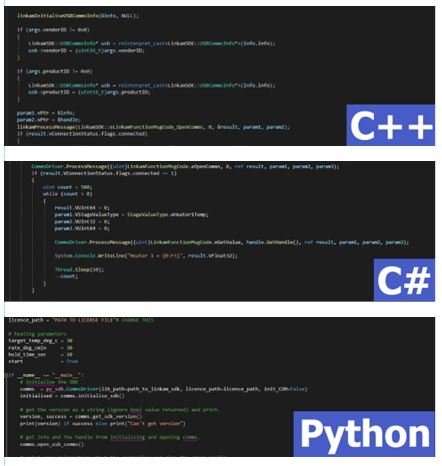SDK
The Linkam SDK (Software Development Kit) is a device driver source development kit, used to control Linkam equipment. The SDK is designed to be used by scientists and engineers with programming skills, who wish to develop their own solutions. Used as the base device driver for Linkam’s software; our SDK offers complete control for Linkam products supported by our T95 and T96 controllers.
C++ shown above
The Linkam SDK is a device driver and has the functionality to drive Linkam equipment and return the data from the device. Data recording and saving must be handled by developers using the SDK. Users seeking a complete software solution should instead purchase our NEXUS software.
The SDK offers the user ease of use, compatibility, (both x86 and x64 environments), and allows integration into wider systems or platforms. The key features are shown below:
Features
Accommodates a variety of applications and solutions including Linkam product integration into commercial systems. (The Linkam SDK requires per machine licensing for distribution of the software).
Provides a platform for the easy integration into third party software applications.
Windows and Linux compatible
Compatible with C++, C#, and Python
Uses simplified methods and properties to handle all communication to Linkam equipment
Uses both USB and Serial protocols
Allows users to write their own code to integrate Linkam equipment into wider systems or platforms
Ideal for customers seeking custom control such as LabVIEW and MATLAB integrations
The Linkam SDK includes all 3 interfaces, as well as documentation and example programs to help you get started.
Select the interface that’s right for you:
· C++ is ideal for experienced software developers who want the maximum amount of performance from their applications.
· C# is designed for developers wanting to implement Linkam equipment into Windows based applications.
· Python is perfect for scientists and engineers with minimal coding experience to experiment and rapid prototype systems.


